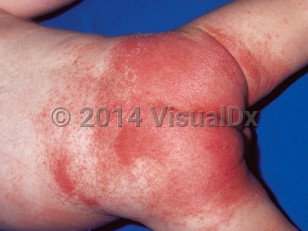Diaper irritant contact dermatitis - Anogenital in
See also in: OverviewAlerts and Notices
Important News & Links
Synopsis

There have been several reports in the literature of laxative use in infants leading to a severe irritant dermatitis. Laxative-induced diarrhea contained and occluded by a diaper can cause bullae and erosions.
Childhood physical and sexual abuse is a problem of epidemic proportions affecting children of all ages and economic and cultural backgrounds. Although awareness is increasing, it is often challenging to differentiate findings attributable to child abuse from other benign skin conditions. Perineal irritation and erythema are common causes for concern but are most likely due to irritant contact dermatitis (often caused by diapers), seborrheic dermatitis, poor hygiene, candidal lesions, and excoriation secondary to pruritus. However, severe diaper dermatitis may be a sign of physical neglect if associated with other risk factors. Additional physical findings increasing the possibility of abuse include marked subcutaneous wasting, xerosis due to chronic avitaminosis, and poor hygiene, often with associated pediculosis capitis.
Related topics: diaper dermatitis candidiasis, Jacquet erosive diaper dermatitis
Codes
L22 – Diaper dermatitis
SNOMEDCT:
91487003 – Diaper rash
Look For
Subscription Required
Diagnostic Pearls
Subscription Required
Differential Diagnosis & Pitfalls

Subscription Required
Best Tests
Subscription Required
Management Pearls
Subscription Required
Therapy
Subscription Required
Drug Reaction Data
Subscription Required
References
Subscription Required
Last Updated:03/03/2024
 Patient Information for Diaper irritant contact dermatitis - Anogenital in
Patient Information for Diaper irritant contact dermatitis - Anogenital in - Improve treatment compliance
- Reduce after-hours questions
- Increase patient engagement and satisfaction
- Written in clear, easy-to-understand language. No confusing jargon.
- Available in English and Spanish
- Print out or email directly to your patient



